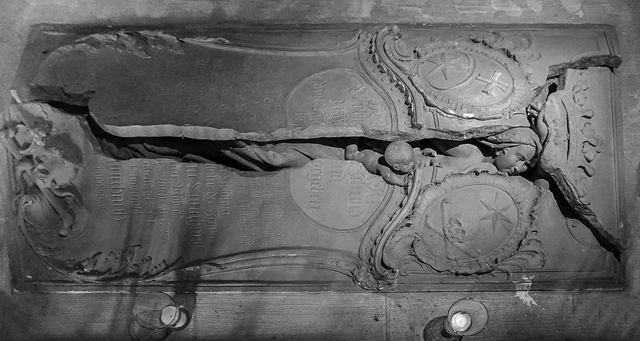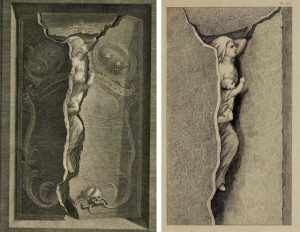SPLIT STONE ON THE TOMB OF MARIA MAGDALENA LANGHANS

If you follow history and historical development of sculptures carefully, very often you can find imitations. What is today considered to be plagiarism and is persecuted by law used to be common in the past. Also, in cases when the copies were, more or less, well done, the beautiful works of art often became a basis for the creation of new works of art that were not less successful than the originals.
That was the case of the statue from Johann Valentin Sonnenschein from the time around 1780. As was found out, it was a replica. Its model was the tombstone of Maria Magdalena Langhans that was made by Johann August Nahl in a village church in Hindelbank in Switzerland in the year 1751.
The artist was making a tombstone for Hieronym von Gerlach at the same time in the village. He was staying with local parish priest Georg Langhans and his wife Marie Magdalen, born Wäber. This is how it happened that he was there when the 28 years old Marie Magdalen died in the Holy Week giving birth to the first child, a boy. The boy died shortly after that.

Acquaforte by Christian von Mechel from 1790, illustration in the catalogue of lectures on sculpting that were presented in front of the members of the Royal Academy in 1865.
Mournful Nahl commissioned a tombstone for the mother and child, out of his own initiative, reminiscent of the Resurrection motive. The work is chiselled out of one piece of stone, and it depicts a split grave out of which Marie Magdalen and her son are looking towards heaven.
The tomb was placed in the floor of the church and covered with a wooden covering which would be opened only during important occasions. In 1911, a huge portion of the church was destroyed by fire. But Nahl’s work survived the catastrophe because it was covered by a wooden covering which protected it from falling debris.
Since the time of its creation, the tombstone has been drawing a lot of interest and many important personalities admired it, among them for example Johann Wolfgang Goethe and Arthur Schopenhauer. Many illegal copies were made already in the 18th century. Current sculptors have followed the author’s concept, for example Günter lang whose work from 1997 has also been done in the form of a split tombstone. Unlike the original work, which is an almost “literal” depiction of the Resurrection, the Lang’s work only shows the open grave as a symbol of spiritual resurrection.
There is no doubt that plagiarism and copying are a form of theft. On the other hand, many works of art are known only thanks to them. Luckily, this was not the case, and we can still admire the original Nahl’s work thanks to the wooden cover that had protected the original piece of art.

A replica of the tombstone of Johann Valentin Sonnenschein from around 1780 and a tombstone from Niderville Porcelain Manufactory in France (around 1787).
Source: Kurier kamieniarski
Author: Kurier Kamieniarski | Published: 27. 2. 2020
